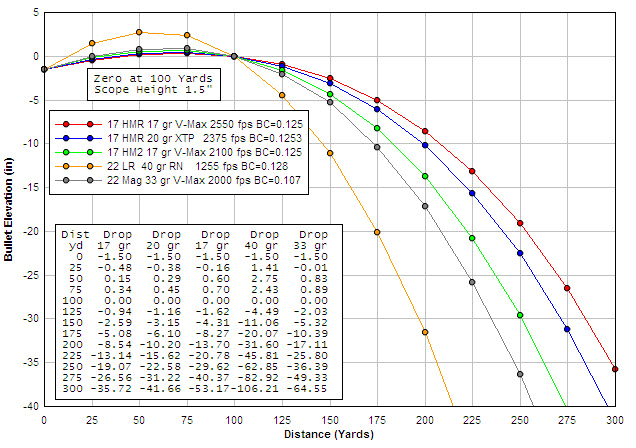Bullet Trajectory Chart .17 HMR .17 HM2 .22 LR .22 WMR
A bullet trajectory chart shows how fast each bullet drops in inches at distances the bullet travels in yards. This bullet trajectory chart compares the .17 HMR, .17 HM2, .22 Long Rifle and .22 Magnum. As you can see the .22 LR 40 grain bullet drops the fastest and has a much higher trajectory than the rest. The .17 HMR 17 grain bullet drops the slowest and has a much flatter trajectory than the .22 LR. Much of that can be attributed to the velocity of the of the .17 HMR 17 grain bullet which is the fastest of the four compared here at a velocity of 2,550(FPS). Compare 22lr Muzzle Velocity and 22lr Muzzle Energy on the 22lr Ballistics Chart! Also look at the 22 WMR Ballistics Chart!

Take a look at the 22LR drop at 200 yards! The 22LR bullet drops roughly 32 inches at 200 yards. As you can see the by the 22 WMR Trajectory Chart which is represented by the gray line; the 22 WMR Bullet only drops roughly 17 inches at 200 yards. That's almost half the drop of the 22LR bullet and as you can see on the trajectory chart the 22 WMR Trajectory behaves much more like the 17 HMR Trajectory than it does the 22LR Trajectory. It's safe to say that the 17 HMR ,17 HM2 and the 22 WMR Bullet Trajectory are much more similar in comparison to the 22LR Bullet Trajectory. The 22LR Bullet Trajectory is much more higher arching for the first 75 yards than the 17 HMR, 17 HM2 and 22 WMR Bullet Trajectory which is much flatter. All four rounds cross their zero distance at 100 yards, then the 22LR Bullet drops like a ton of bricks.
.17 HMR vs .22 LR Ballistics
The Down and Dirty of Ballistic Vocabulary:
Bullet Weight: weight of bullet in grains, there are 7000 grains in one pound; the abbreviation for grains is gr.
Ballistic Coefficient (BC): of a bullet is the drag factor of a bullet. The number is in the form of a decimal. The higher the number the lower the drag of the bullet. As a general rule the higher the velocity of a given
bullet the higher it’s BC and the lower the drag on the bullet.
Muzzle Velocity: The speed or velocity with which a bullet
leaves the barrel measured in feet per second (FPS). As a rule the faster the muzzle velocity the
shorter the bullets time in flight and there for a flatter trajectory and less
drop.
Check out MCARBO Performance Parts & Accessories for your Firearm Here!
You've got a misprint in the 2nd paragraph where you write ".17HMR2" a couple of times instead of 17HM2. As for questions, why did you use the trajectory of the decidedly non-standard 30gr Hornady 22WMR instead of one of the more common 40gr, 45gr Dynapoint or 50gr Federal loads? Just askin'...